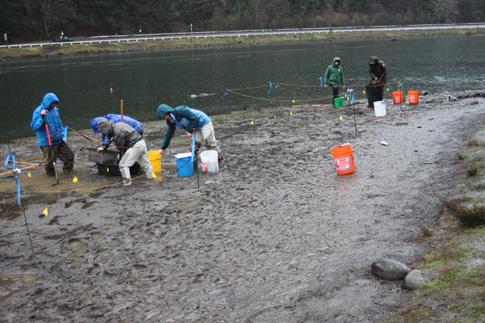Related News
Related News
-
EWEB secures $2.5 billion of reliable, affordable, carbon-free energy for customers
The new contract with EWEB’s largest energy supplier, the Bonneville Power Administration, forms the foundation of a diverse energy portfolio.
Find Out More -
EWEB Hometown Heroes compete internationally
Out of 290 teams from 14 different countries, EWEB's Lineman Rodeo team places in the top third of competitors.
Find Out More -
Sustainability Snapshot - Celebrating Energy Efficiency Projects in the Community
Sustainability Snapshops highlight impactful projects completed by EWEB's Customer Solutions department, as a way to celebrate the meaningful work happening behind the scenes.
Find Out More -
EWEB completes helicopter installation of salmon habitat features
EWEB adds downed trees and 2,000 tons of gravel to the Uupper McKenzie River below Tamolitch Falls to improve spawning habitat.
Find Out More -
Court rules in favor of EWEB in Carmen-Smith litigation
The U.S. District Court in Eugene has granted EWEB's motion to dismiss a lawsuit brought under the Endangered Species Act pertaining to fish passage at EWEB’s Trail Bridge Dam. The favorable ruling clears the way for EWEB to continue advancing towards implementation of permanent fish passage at the dam.
Find Out More -
EWEB proposes modified plan for permanent fish passage at Trail Bridge Dam
After eight months of extensive collaboration and analysis with scientific experts at two federal regulatory agencies, EWEB is proposing an improved plan to build permanent fish passage facilities at Trail Bridge Dam on the McKenzie River.
Find Out More -
Sustainability Snapshot - Ideal Steel July 2025
Our second Sustainability Snapshop highlights a project where EWEB helped a local industrial warehouse upgrade over 1,000 flourescent lights to new efficient LEDs.
Find Out More -
EWEB prepares for wildfire season with risk mitigation measures
EWEB is building a more resilient electric system to weather various types of disasters, from wildfire to winter storms.
Find Out More -
Improving habitat resiliency throughout the Upper McKenzie
Environmental Responsibility is a core guiding value for EWEB decision-making. This summer, EWEB continues its commitment to environmental stewardship with a robust slate of habitat enhancement updates throughout the upper McKenzie River, across the footprint of the Carmen-Smith Hydroelectric Project.
Find Out More -
EWEB weighs multi-billion-dollar decision affecting energy supply
EWEB is weighing energy supply decisions that will cost nearly $2 billion over the next two decades.
Find Out More -
EWEB opens applications for 2025 Electric Mobility Community Grant
The Eugene Water & Electric Board is now accepting applications for the 2025 Electric Mobility Grant, reinforcing EWEB's commitment to sustainability and cleaner transportation.
Find Out More -
Greenpower subscribers vote to award Greenpower Grant to SquareOne Villages
The Greenpower Grant, funded solely by voluntary customer subscriptions, supports local sustainability projects.
Find Out More -
EWEB reaffirms commitment to resilience with Wildfire Mitigation Plan approval
The utility is testing new equipment, leveraging technology, and incorporating third-party expertise to bolster electric system resiliency to a range of threats, including wildfire.
Find Out More -
Vote now for the winner of the 2025 Greenpower Grant
Get ready to cast your vote for the winner of the 2025 Greenpower Grant. EWEB is excited to announce the eligible candidates for this year's grant award! The winner of the Greenpower Grant will be voted on by Greenpower subscribers. Learn more about each origanization and their proposal before casting your vote.
Find Out More -
How EWEB’s Fleet Services reached 200,000 hours without a lost time injury
EWEB’s Fleet Services team reached a major safety milestone: 200,000 work hours without a workplace injury that results in an employee losing at least one full day of work.
Find Out More - Show More
EWEB Partners With Agencies to Study Lampreys
March 23, 2018

We are partnering this week with the Oregon Department of Fish and Wildlife, the U.S. Fish and Wildlife Service and other agencies to study methods to preserve young Pacific and brook lamprey during lake and reservoir drawdowns.
Lampreys belong to a primitive group of fishes that are eel-like in form but lack the jaws and paired fins of true fishes. Lampreys have a round, sucker-like mouth, no scales and gill openings. Lamprey are culturally significant for many Native American tribes in the Pacific Northwest.
When reservoirs are drawn down rapidly, biologists worry that young lampreys may not be able to "follow the water" quickly enough and could become stranded and die.
To help biologists and fisheries managers study methods to help lampreys escape de-watering situations, our Generation staff slowly lowered the level of Leaburg Lake. Juvenile and larval lamprey are known to live in the silt along the southeast shoreline of the lake, above Leaburg Dam on the McKenzie River, 26 miles east of Eugene.
"This is a unique opportunity for fisheries managers and biologists to study behavior during a slow drawdown," said Andrew Janos, an EWEB biologist. "What they learn could help them establish best practices for drawdowns at other locations in the Northwest."
Starting early on March 22, staff began lowering the level of the lake at a rate of 1.8 inches per hour. The slow drawdown continued until the lake level dropped by about 1.5 feet. The drawdown resumed on March 23, when staff will slowly lowered the lake another 1.5 feet.
We contacted state and federal fisheries managers in 2017 to begin working on the study. Over the next two to five years, we are planning to remove a portion of the significant silt build-up along the left bank of the dam to improve the upstream fish ladder passage for migrating salmon. Working with the agencies to conserve the lamprey larvae and juveniles during future silt removal operations is a high priority as we strive to be good stewards of the McKenzie River.
Pacific and brook lamprey populations have declined in recent decades, and biologists are looking for ways to promote the preservation of the species.

